The last time Marseille enjoyed that trophy-winning feeling came over a decade ago when they won the now-abolished Coup de la Ligue in 2012. To find out when Les Phocéens last took home the Ligue 1 title, we have to go back to the 2009/10 season as club legend Didier Deschamps guided OM to their first major title since the Champions League win of 1993, where Deschamps lifted the trophy as club captain.
In October 2016, American businessman Frank McCourt bought Olympique Marseille for a fee of €45m. This deal represented a new era for the club as McCourt pledged to invest €200m into the club over a four-year period.
McCourt appointed Rudi Garcia as manager and spent big in his first transfer window, bringing in the likes of Dimitri Payet, Patrice Evra and Morgan Sanson. Under Garcia’s guidance, OM managed to finish fifth, fourth and fifth again during the three years he was in charge. A rather turbulent year with Andre Villas-Boas at the helm followed, as Marseille recorded a second-place finish in the 2019/20 campaign, which was concluded prematurely due to the pandemic.
The summer of 2020 represents a significant moment in Marseille’s recent history – the appointment of Pablo Longoria — first as Sporting Director, later as President of the club. The Spaniard is tasked with making the decisions of all things football and financial as OM look to become a force to be reckoned with once again.
It hasn’t all been plain sailing, though; in February 2021 Villas-Boas resigned from his position as manager due to a disagreement regarding transfer business. In came Jorge Sampaoli with his Bielsa-inspired brand of football, which lasted for 17 months until he departed the club, citing frustrations with their transfer policies as the reason for his exit. Igor Tudor took over the manager’s hot seat for the 2022/23 campaign and recorded a 3rd-place finish in Ligue 1.
For the season ahead, Longoria has turned to Marcelino. The two have previously enjoyed a fruitful working relationship, as the former Sevilla manager reportedly used Longoria’s analysis skills during his time at Racing Santander. The pair linked up again as Longoria was made sporting director of Valencia in 2018, coinciding with Marcelino’s manager reign.
At 37 years of age, Pablo Longoria has worked with clubs such as Newcastle United, Recreative Huelva and Serie A giants Juventus. The Spaniard is tasked with building an OM side capable of challenging PSG for the Ligue 1 title. Whilst there have been some tumultuous times, Longoria has made some incredibly astute decisions that are starting to pay dividends as Marseille finally look like they could be ready to compete at the top again.
This tactical analysis will take the form of a data analysis where we analyse Longoria’s transfer decisions over the last three seasons and look at the statistics of how well they performed. Of course, we will look into the tactics of the then managers and how they utilised Longoria’s signings along the way.
Laying the foundations
In this section of the analysis, we will look at some of the numbers behind McCourt’s ownership and Longoria’s influence on the club. The data visual below demonstrates where OM have finished in Ligue 1 each season since Frank McCourt took ownership (as we have discussed above).
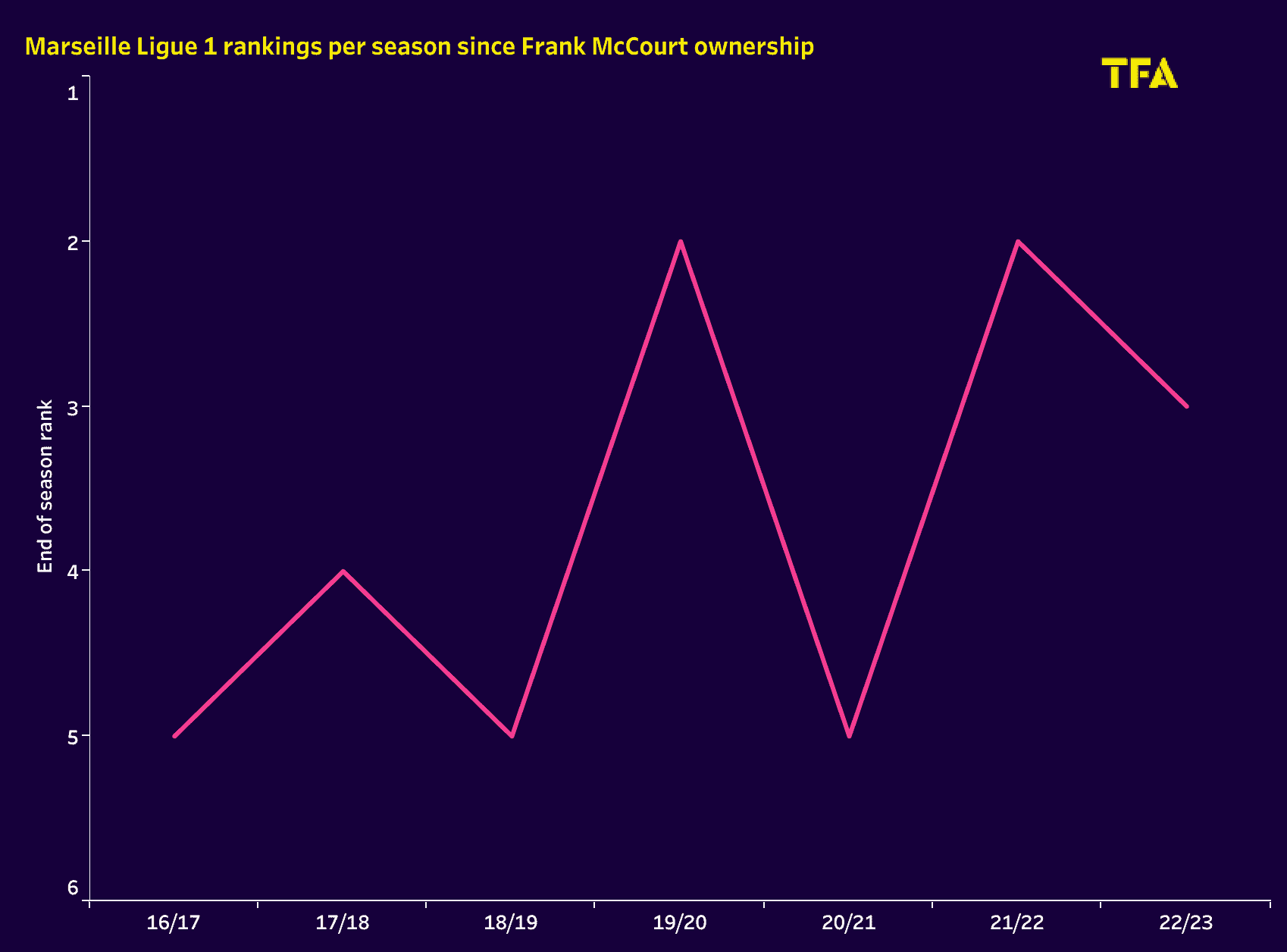
On a positive note, OM never finished below 5th in Ligue 1 since the American businessman bought the club. Since Pablo Longoria was hired in July 2020, the club has finished fifth, second, and third last season. Perhaps last season’s third-place finish rankles Marseille fans a little, as they didn’t take advantage of PSG’s struggles with Les Parisiens eventually stuttering to the title.
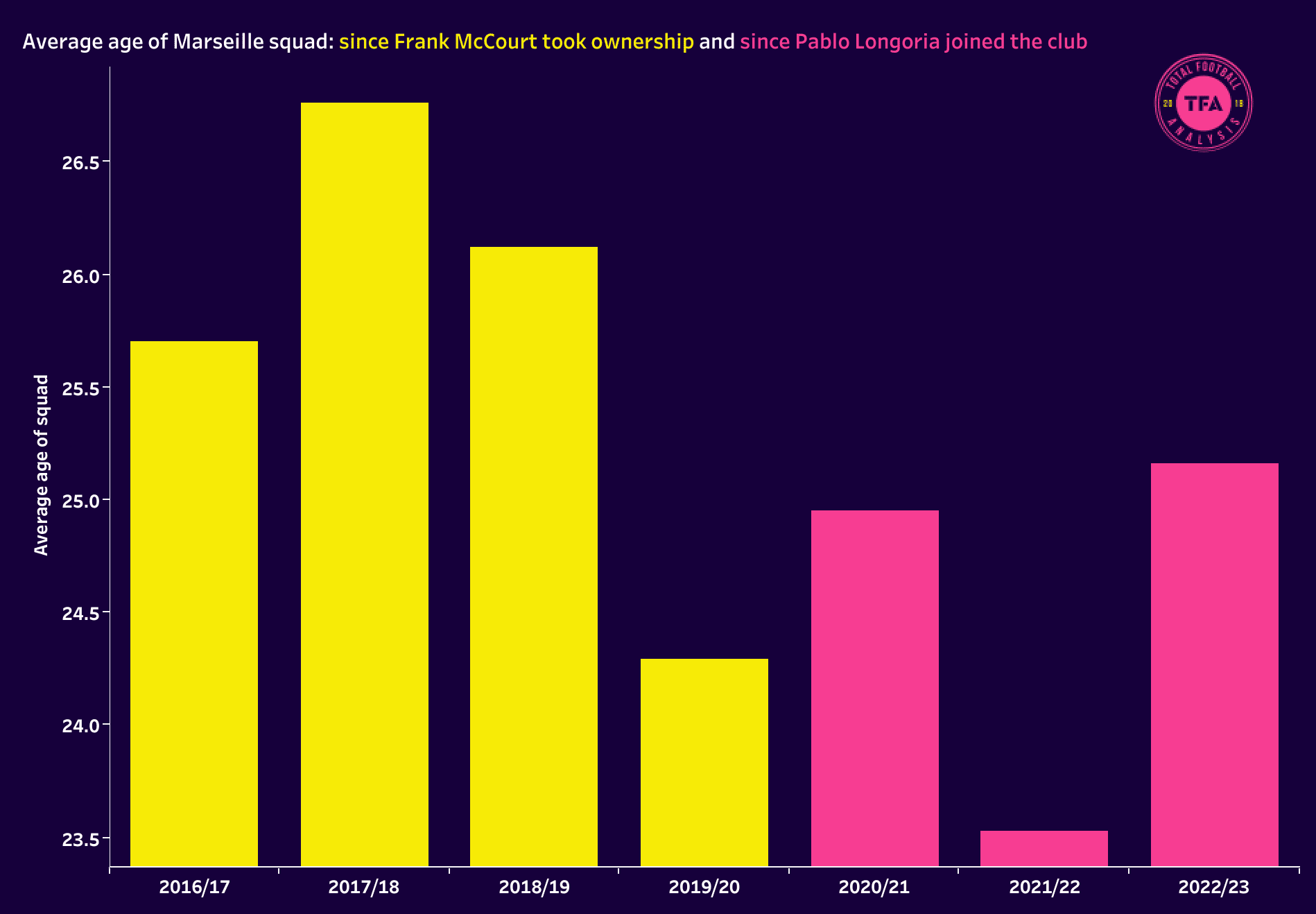
Via the data viz above, we can see how the average age of the squad has changed over the last seven seasons from 2016-2023. We can see specifically in Longoria’s first season at the club that the average age of the squad was 24.9 years. Interestingly, the following season (2021/22), the year that OM achieved their 2nd place finish, the average age of the squad was the lowest it’s ever been under the McCourt ownership – 23.5 years old.
From a financial perspective, young players can generate significant value through transfers. As they develop and showcase their potential, they can attract interest from bigger clubs, both domestically and internationally. Selling these players later can result in substantial transfer fees, providing the club with a source of revenue that can be reinvested in the team or used to strengthen the club’s financial stability.
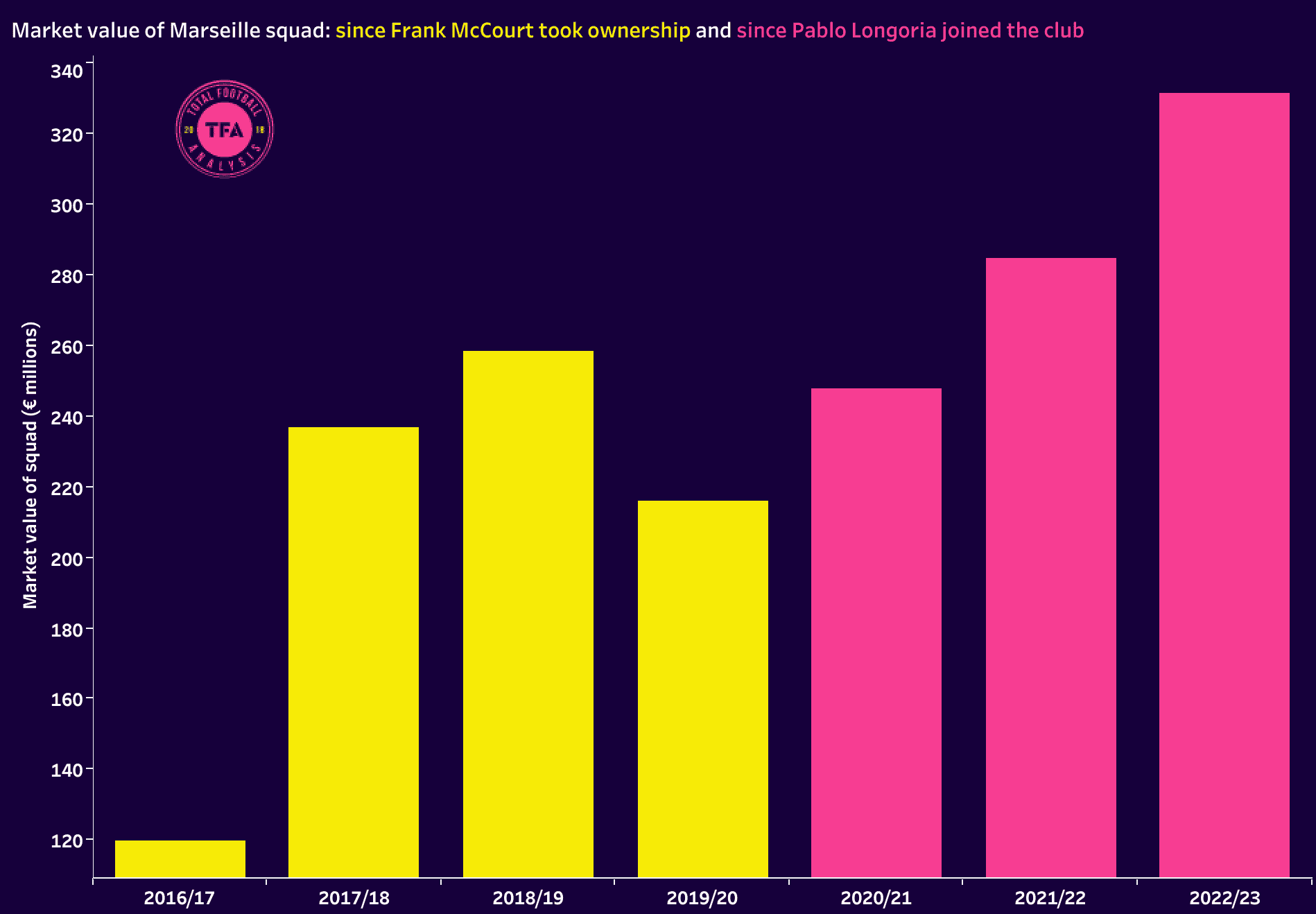
Using this data visual, we can see how the market value of the OM squad has changed over the last seven seasons. Understandably, the squad was at its lowest value during the 2016/17 season — McCourt’s first season as owner. Since then, the market value of the Marseille squad has risen. As we can see from the visual, since Pablo Longoria was brought in as Sporting Director, there has been an exponential, year-on-year increase in the market value of the squad.
“My last great adventure”
The quote above is how Pablo Longoria has described his time at Marseille. After initially considering it a short-term project, he appears to have had a change of heart and intends to oversee the long-term project at the club as they look to rebuild. This can only be a good thing for the club as the Spaniard has shown he can attract quality players to the club who buy into his vision, as we will discuss in this section of the analysis.
2020/21 season: 5th in Ligue 1
Manager(s):
- Andre Villas-Boas (until 2nd February 2021)
- Nasser Larguet (Interim 3rd February – 26 February 2021)
- Jorge Sampaoli (From 26th February 2021)
Transfers:
- Income: €32.05m
- Expenditure: €17.45m
The 2020/21 season was a little tumultuous, to say the least, still in the middle of the global pandemic, which, of course, impacted the club’s finances and the transfer market as a whole.
To bolster the defence, centre-back Álvaro González joined for €4m after a successful loan spell during the previous season. Midfielder Pape Gueye also joined the club during the summer window, though both these signings took place before Longoria officially joined the club.
Leonardo Balderdi joined as a loan signing from Borussia Dortmund. OM further utilised the loan market as Michaël Cuisance joined on a season-long loan from German giants Bayern Munich in October.
Pablo Longoria continued doing business relatively intelligently, bringing in young Brazilian forward Luis Henrique for €8m. At 18 years old, Henrique represented a positive signing for the future for a small fee; the youngster made 19 Ligue 1 appearances during this season, mainly from the bench, as a replacement for the ageing Benedetto and Thauvin.
Additionally, acquiring experienced left-back Yuto Nagamoto on a free transfer appeared to be smart business, as he made 25 appearances over the season.
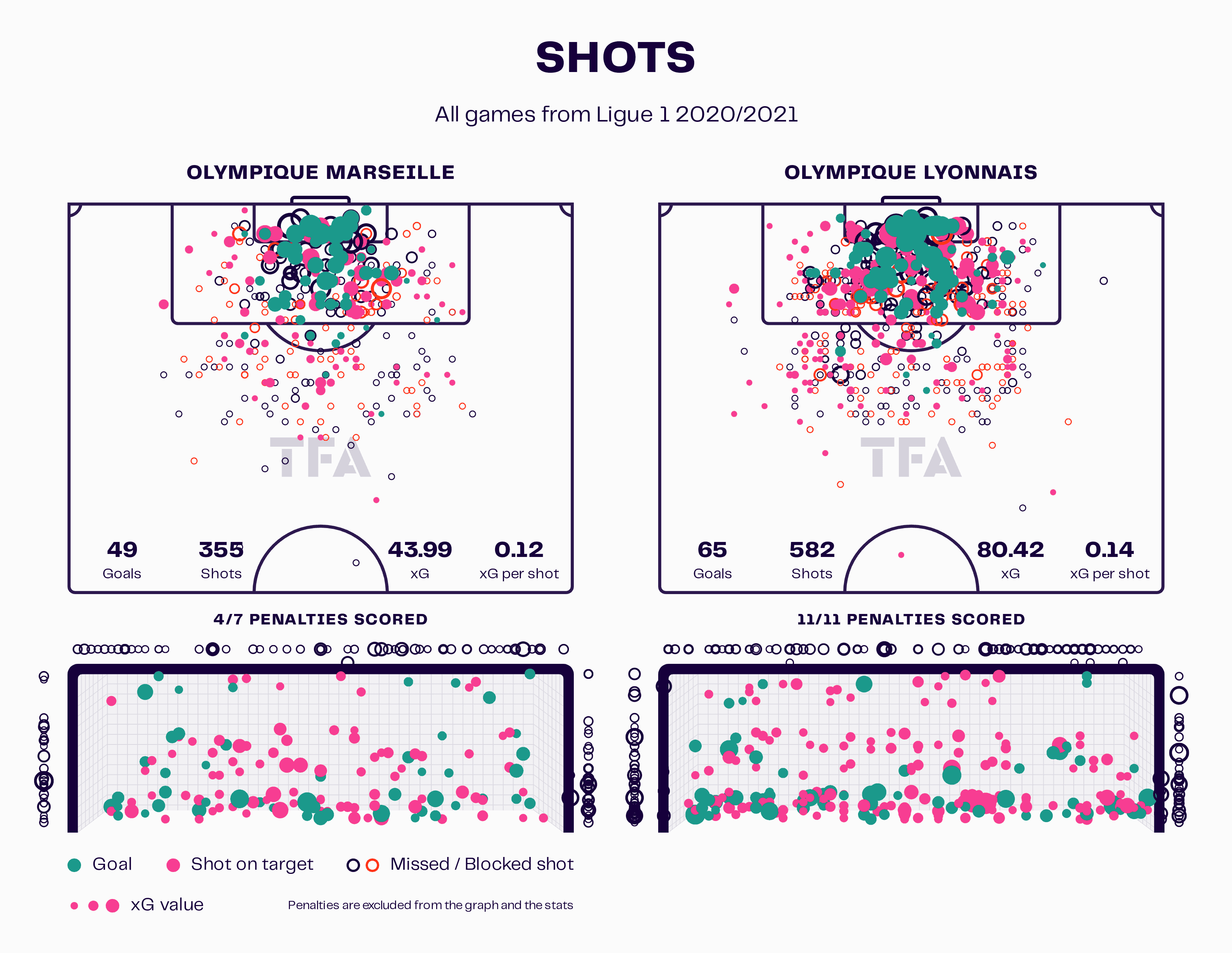
Goals were hard to come by during this campaign, as OM managed to find the back of the net just 54 times. By comparison, fourth-placed Lyon scored 80 goals during the 20/21 season, as we can see via the data visual.
Seeking to address the need for more goals, Longoria brought in Polish striker Arkadiusz Milik on a loan deal in January. Milik’s arrival had a positive effect as he finished as the club’s top scorer with nine league goals.
Other January arrivals include right-back Pol Lirola, who joined on loan from Fiorentina, while Olivier Ntcham signed for OM on loan from Celtic. He was considered the short-term replacement for Morgan Sanson, who was sold to Aston Villa for €15.8m. It was the deal for Ntcham which resulted in the departure of Villas-Boas, as he felt that the club went against his wishes with this transfer.
Tactically, OM used a few different formations during this season. Villas-Boas preferred a 4-3-3, 4-1-4-1 or a 4-3-1-2 system, whilst Sampaoli opted for a 3-4-2-1 or a 3-5-2 system.
Throughout the Ligue 1 season, Marseille averaged 1.42 goals per 90 from an xG of 1.3 per 90 with an average of 9.53 shots per 90. At the other end of the pitch, OM conceded 1.24 goals per 90 which led to them letting in 47 over the season from an xGA of 41.56, as shown below.

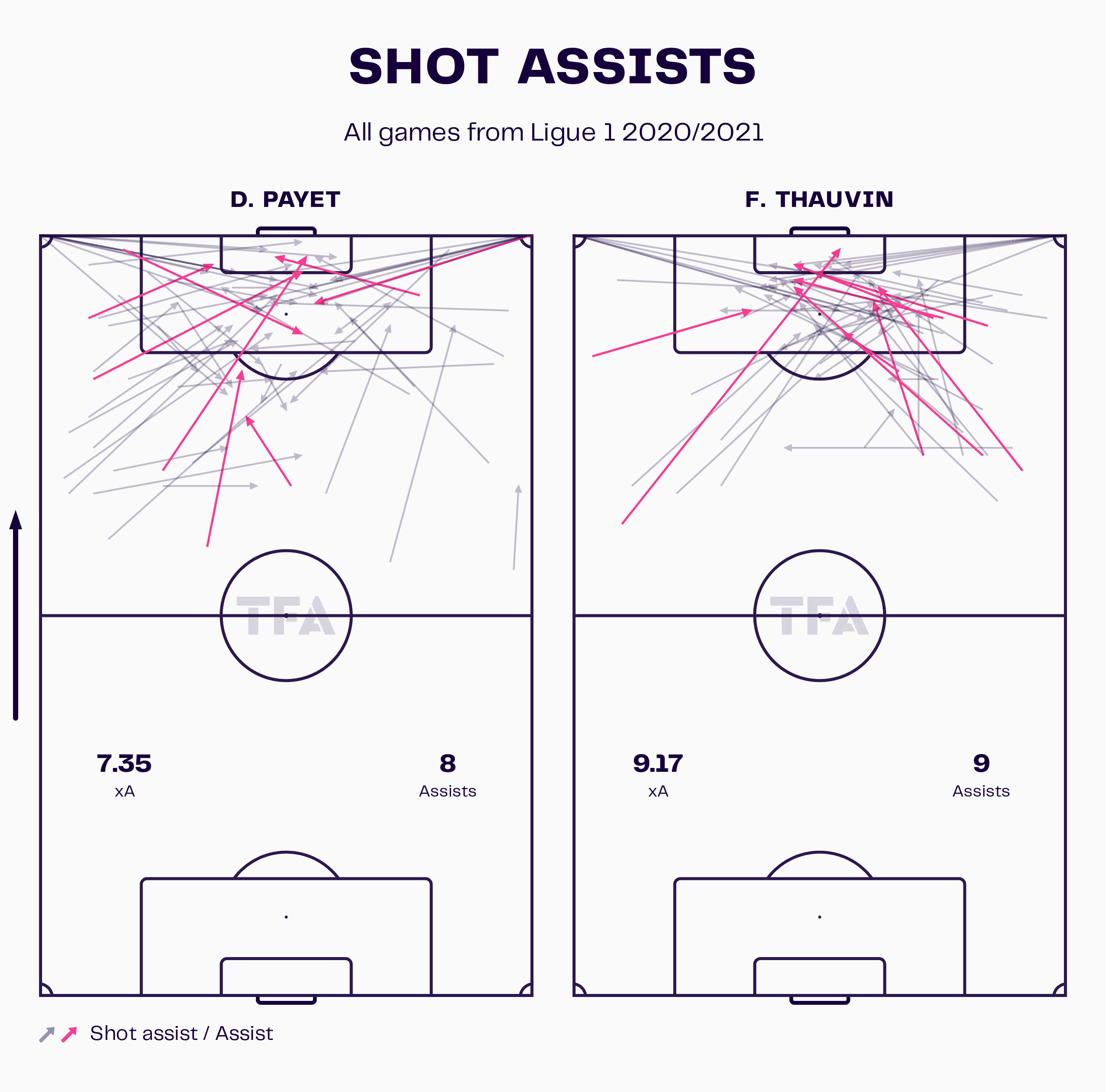
Two of OM’s key players this season were Dimitri Payet and Florian Thauvin; the pair were primarily used as the two attacking midfielders under Sampaoli in his 3-4-2-1, and under Villas-Boas, one was played as a ‘10’, or both were occasionally used as wingers with Payet on the left and Thauvin on the right. From the data visual above, we can see that Payet chipped in with eight assists while Thauvin provided nine assists for his team.
To summarise, this campaign was difficult for Marseille, with multiple managers and a lack of goals.
2021/22 season: 2nd in Ligue 1
Manager(s):
- Jorge Sampaoli
Transfers:
- Income: €8.00m
- Expenditure: €54.12m
Moving on, we’ll assess the 2021/22 campaign — Sampaoli’s first and only full season in charge. During the summer transfer window, Pablo Longoria made fantastic use of the loan market, bringing in William Saliba and Matteo Guendouzi on loan from Arsenal; the latter came with an option to buy should Marseille and Sampaoli be suitably impressed.
Pol Lirola and Leonardo Balerdi both signed permanently after impressing on loan the previous season. Cengiz Ünder, Amine Harit and goalkeeper Pau López also joined the club on loan deals.
Longoria then spent big, bringing in Brazilian midfielder Gerson for €25m from Flamengo as OM sought to improve their midfield. Plus, defender Luan Peres joined from Santos for €4.5m, and talented youngster Konrad de la Fuente came in from Barcelona for a fee of €3m. Sead Kolašinac joined the club in January, further improving the defensive ranks.
Tactically, Jorge Sampaoli began the season playing a 3-4-2-1 system as he had used previously. He then used various systems throughout the season, including a 3-5-2, 4-4-2 and 4-1-4-1, mainly depending on the opponent.
This season saw Marseille enjoy a much more possession-based game, averaging 61.76% per 90 compared with the previous season’s 53.08%.
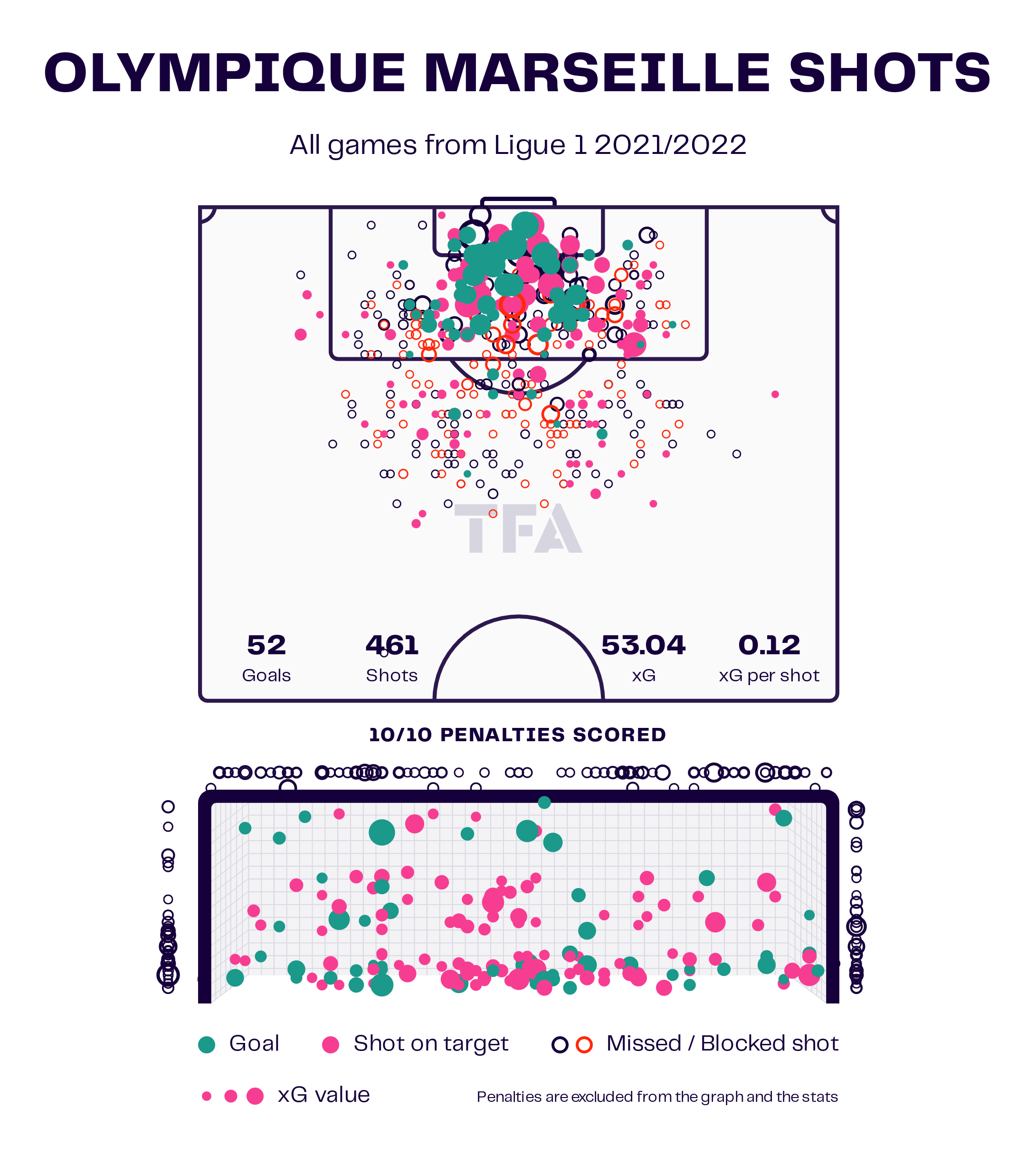
Under Sampaoli, Les Phocéens averaged 1.66 goals per 90 from an xG of 1.6 per 90. As we can see from the data visual above, they bagged 52 non-penalty goals from an xG of 53.04, so it’s fair to say that Marseille were in good goalscoring form this season. The goals were spread across the team as Milik bagged seven Ligue 1 goals, whilst Payet found the back of the net ten times and contributed eight assists.
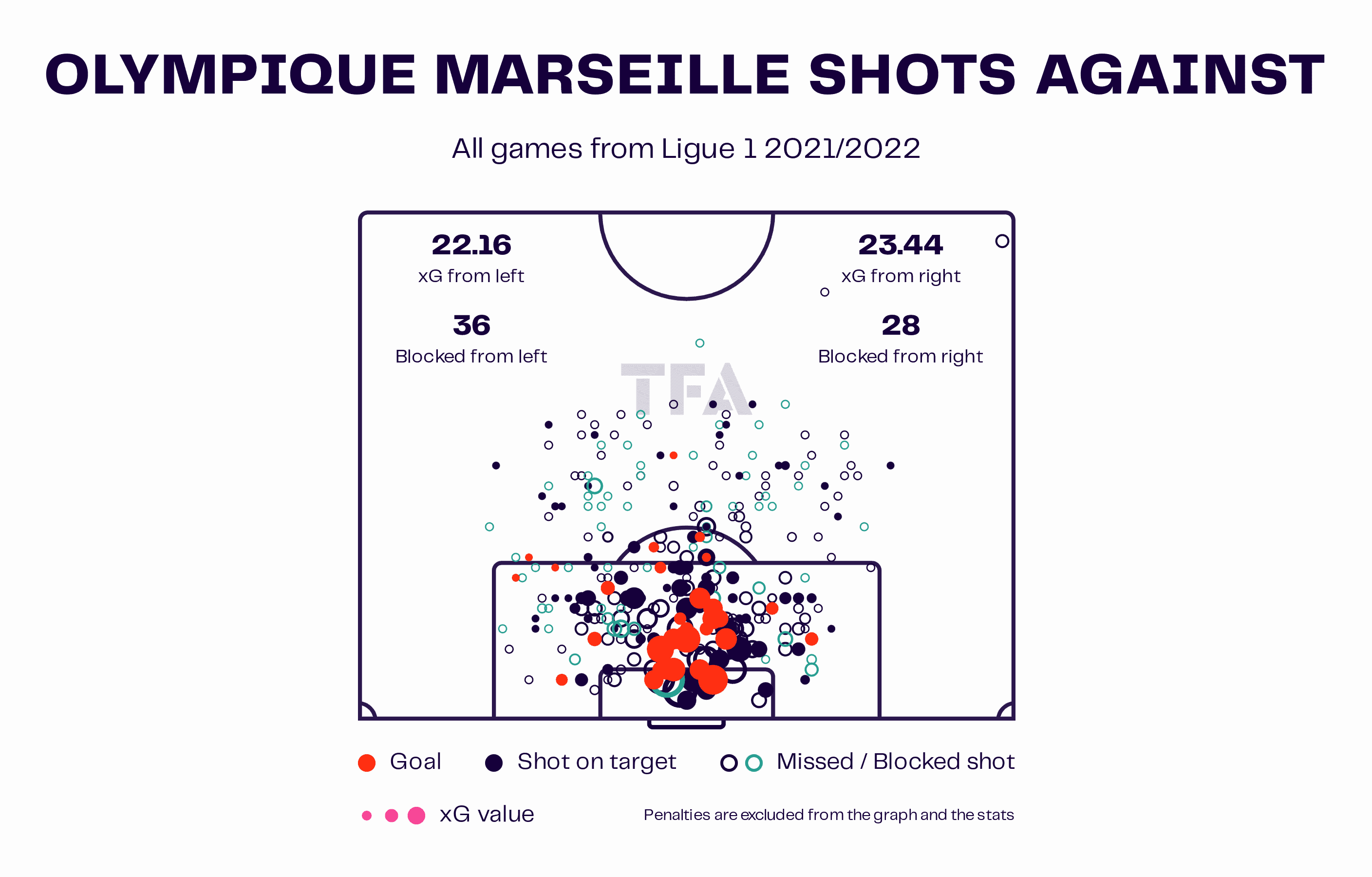
Moreover, Marseille conceded 38 goals throughout the 2021/22 campaign. This was the second lowest amount, as only PSG and Nice conceded less (both with 36). This represented a good improvement from the 47 goals conceded the previous season.
The performances of Matteo Guendouzi and Gerson were integral to Marseille’s second-place finish during this campaign.
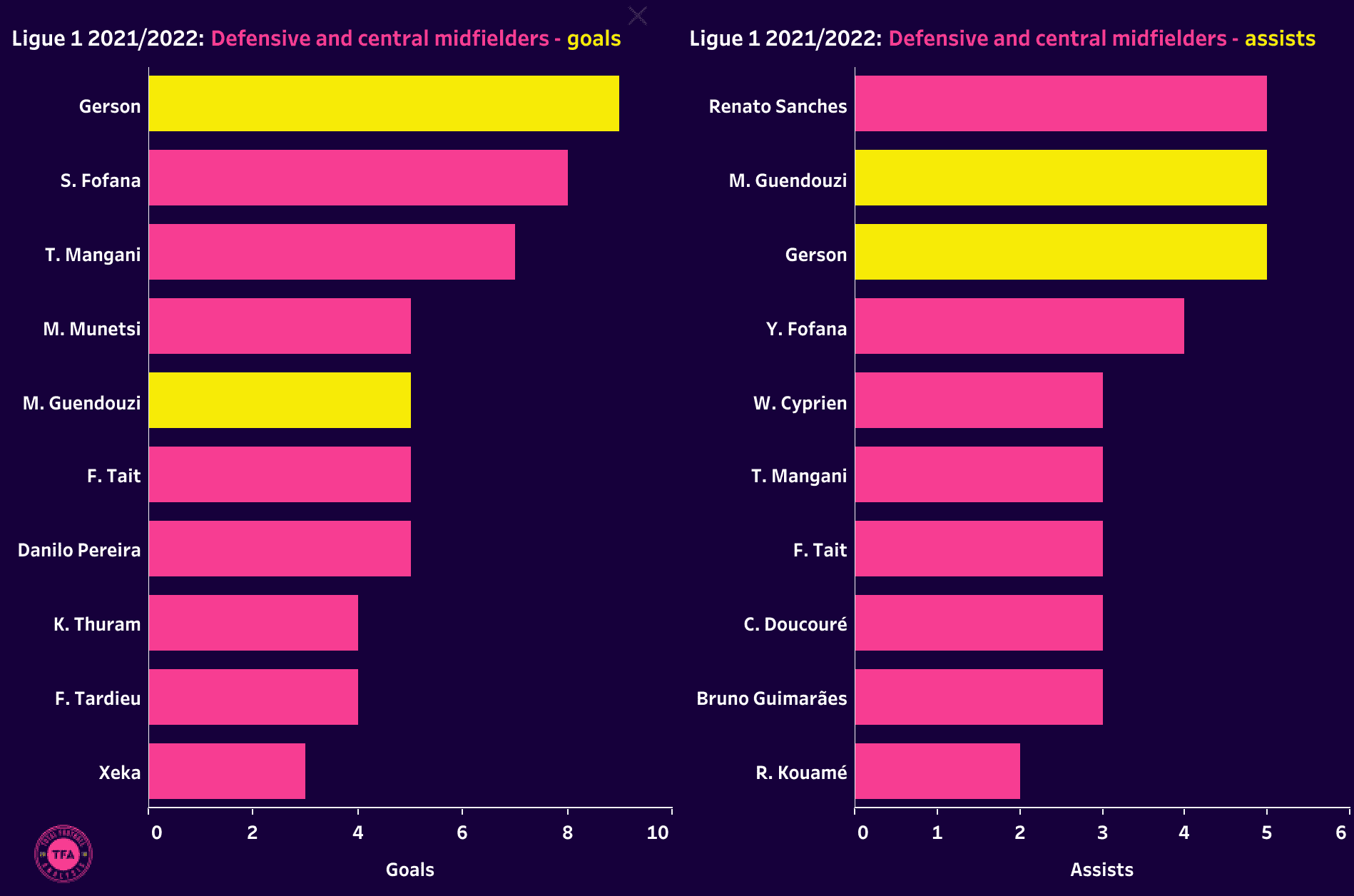
From the data visual above, we can see that €25m man Gerson scored nine goals during the 21/22 campaign, making him the highest-scoring central midfielder in Ligue 1 that season. Guendouzi also contributed five goals from his midfield role, and both players chipped in with five assists alongside Lille’s Renato Sanches.
Having midfielders who can score goals adds an extra dimension to a team’s attacking options. While strikers and wingers are typically expected to score, having midfielders contribute to the goal tally diversifies the sources of goals. This makes the team less predictable and more challenging for opponents to defend against.
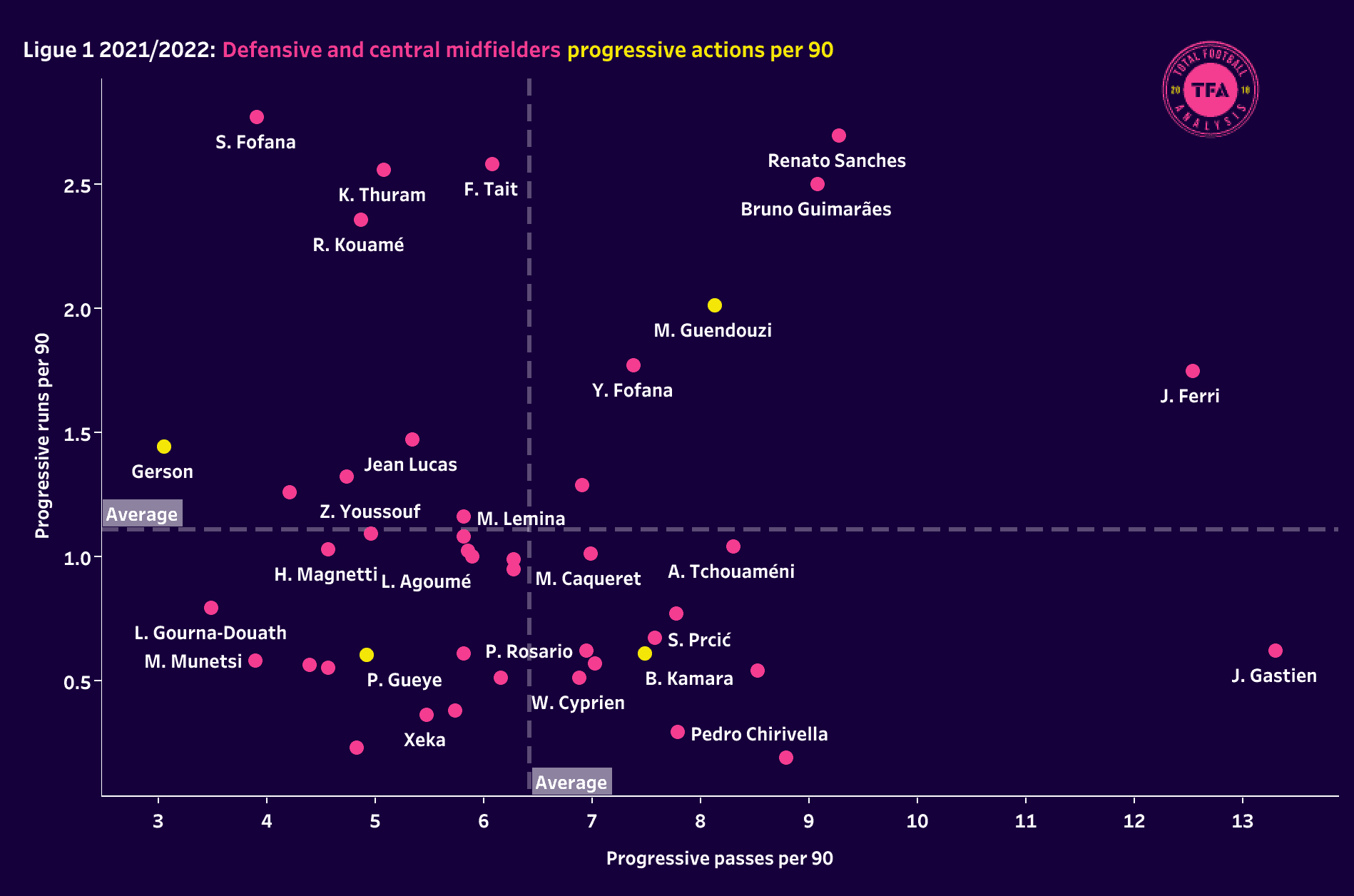
The data visual above details the number of progressive passes and progressive runs the central and defensive midfielders made per 90 in Ligue 1 during the 2021/22 season.
We can see how influential the Marseille midfielders were during this time, particularly Guendouzi and Gerson. The Arsenal loanee performed above average in both metrics, averaging 8.13 progressive passes per 90 and 2.01 progressive runs per 90. Gerson also contributed 3.05 progressive passes per 90 and 1.44 progressive runs per 90.
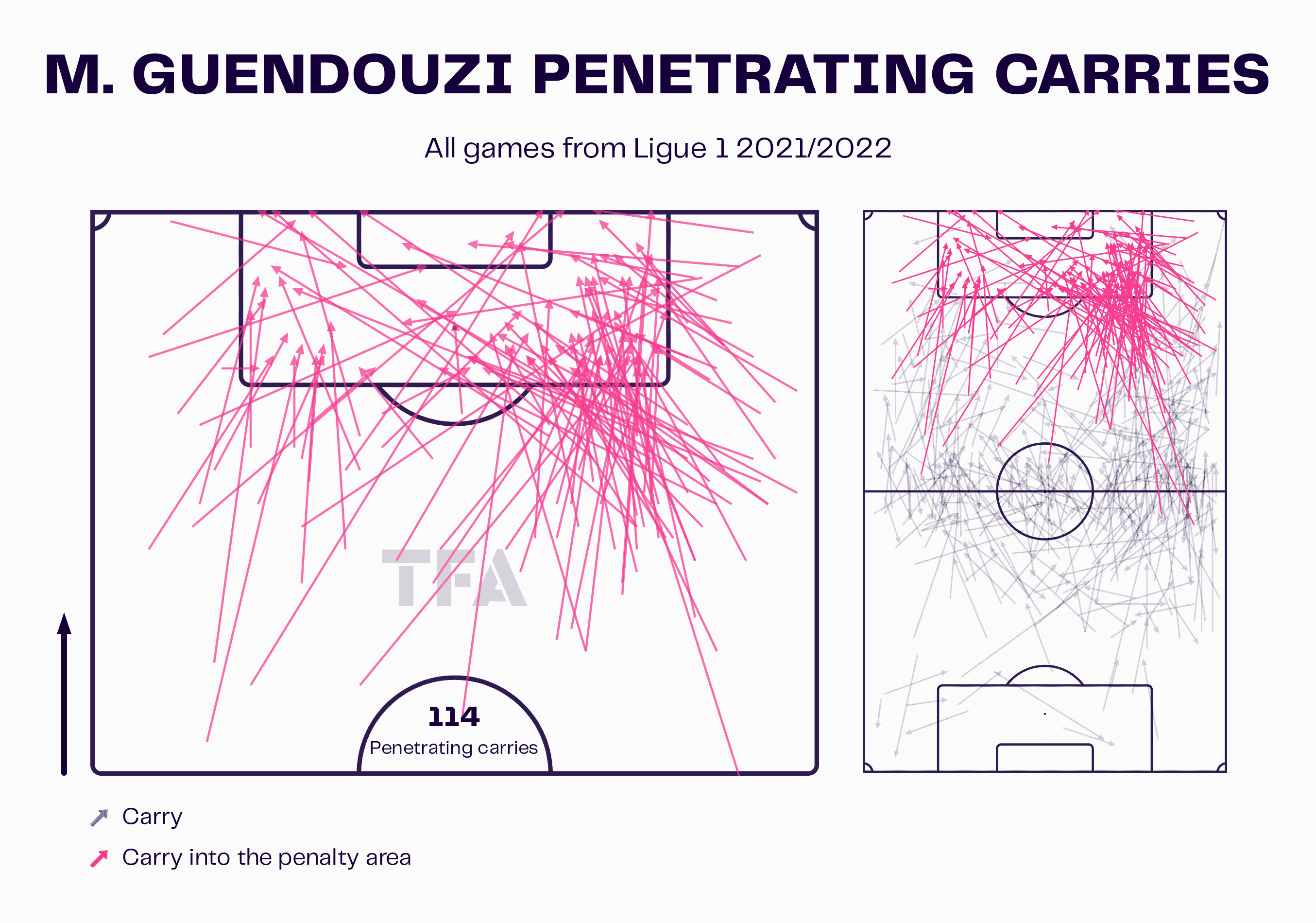
The data viz allows us to observe that Guendouzi was very effective at carrying the ball into the opposition penalty area. He contributed 114 carries into the opponent’s area, which shows how integral he became to this OM attack.
Having a midfielder such as Guendouzi, who can effectively carry the ball into the opposition area, adds an element of unpredictability to the team’s attacking strategy.
When a central midfielder takes on the responsibility of dribbling into the opposing area, it creates uncertainty among defenders. It makes it harder for them to anticipate the team’s next move. This uncertainty can lead to defensive errors, spaces opening up, and goal-scoring opportunities emerging.
Furthermore, Guendouzi’s ability to drive into the opposition area is a great way to break through lines. His dribbling skills and ability to carry the ball can force defenders to step out of position, creating gaps that teammates can exploit.
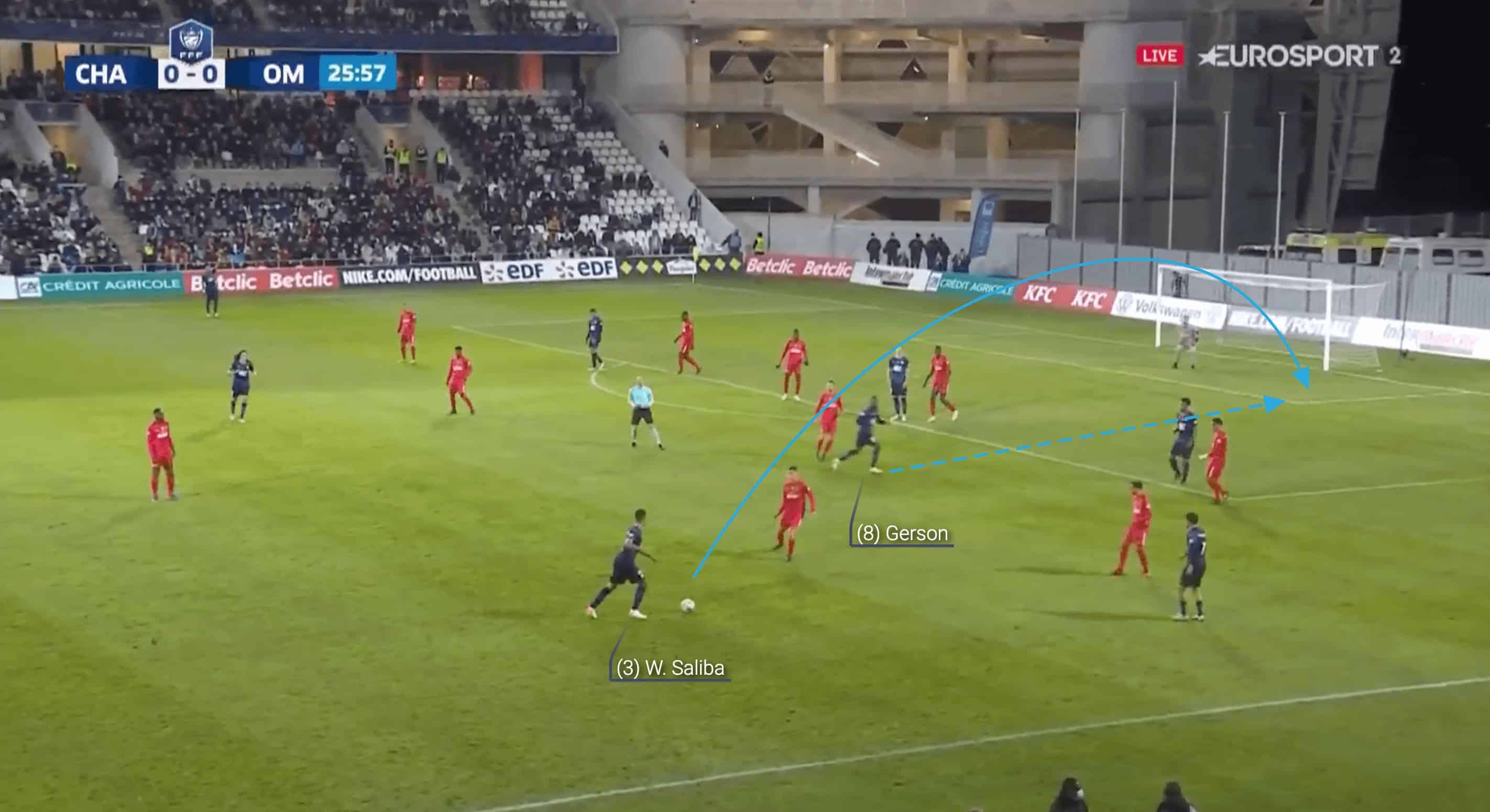
The centre-backs also became vital to Sampaoli’s tactics as the likes of Saliba and a rejuvenated Ćaleta-Car were able to play progressive passes which were highly beneficial with the runs of Guendouzi and Gerson, which broke through the opposition line so often as demonstrated above.
This data viz below allows us to see the progressive passes of the aforementioned Ćaleta-Car and Saliba. This added an extra layer of depth to the team’s build-up play. Instead of relying solely on midfielders to distribute the ball, these defenders were able to initiate attacks from deeper positions.
By picking out teammates in more advanced areas with accurate long passes or incisive through balls, they were able to effectively bypass opponents’ lines and create faster, more direct routes to the goal.
The proficiency of central defenders in making progressive passes also influences their team’s spatial awareness and positional play. When defenders can accurately pick out players in advanced areas, it encourages their teammates to create intelligent movement and find spaces to receive the ball, as we saw with Guendouzi and Gerson’s forward runs.
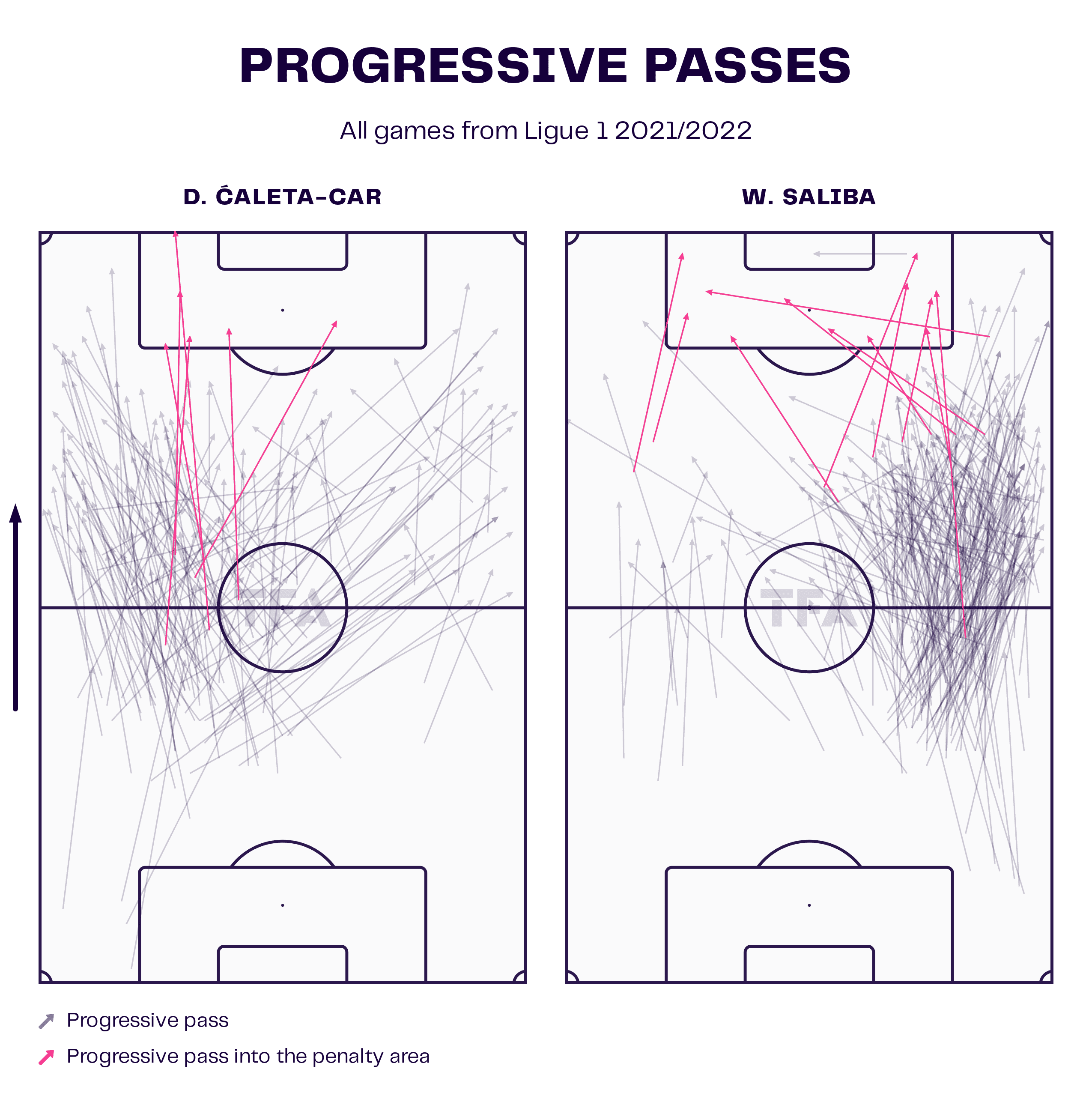
Overall it was a good season for Marseille as they secured Champions League football, and Longoria’s transfers were influential in the team’s second-place finish.
2022/23 season: 3rd in Ligue 1
Manager(s):
- Igor Tudor
Transfers:
- Income: €37.48m
- Expenditure: €118.40m
Igor Tudor came in for the 2022/23 season after Sampaoli departed the club due to being unhappy with the transfer business. After a relatively slow start to the transfer window, Pablo Longoria secured deals for four of last season’s loanees. Matteo Guendouzi (€10.5m), Pau Lopez (€12m), Cengiz Ünder (€10.5m), and Arkadiusz Milik (€9m). Amine Hairit initially re-signed on another loan deal, which was made permanent later in the season.
Longoria continued to go all out during the summer window as he looked to provide Tudor with a solid defence in came Chancel Mbemba from Porto on a free, Jonathan Clauss from Lens (€7.5m), Nuno Tavares on loan from Arsenal, Issa Kabore on loan from Manchester City and Eric Bailly on loan from Manchester United.
Midfielder Jordan Veretout signed from Roma for €11m, and Alexis Sanchez also joined OM on a free transfer from Inter Milan. Longoria shelled out €10m to bring Colombian forward Luis Suárez to Stade Vélodrome. However, the player struggled to make an impact and was loaned out at the first opportunity.
Longoria’s excellent transfer business continued in January as the highly sought-after midfielder Azzedine Ounahi signed for €10m from Angers after some impressive displays in the 2022 World Cup. Ruslan Malinovskyi signed on loan from Atalanta, and Vitnha joined from Braga for a fee of €32m representing Longoria’s most expensive signing to date.
There were also many outgoings during this season. The most significant loss, though, came in the form of Boubacar Kamara. The defensive midfielder joined Premier League side Aston Villa on a free transfer. This was perhaps Longoria’s poorest decision since joining OM; Kamara reached a peak value of €37m during the previous season and stated his intentions to leave, so for him to depart a year later on a free transfer perhaps represents a missed opportunity in terms of gaining some transfer income.
Tactically, Tudor brought a different style to the table compared to what we had seen with Sampaoli. The former Hellas Verona manager primarily used a 3-4-2-1 or a 3-4-3 formation with an average possession of 57.26% per 90.
Despite Sampaoli’s Bielsa-inspired tactics in 21/22, Marseille averaged a PPDA of 11.88. This number dropped dramatically to 7.99 during Tudor’s reign at OM. We can see from the data viz below that OM completed 628 counter-pressing recoveries, with 434 of them being classed as ‘high regains’, meaning they occurred in the attacking third. Additionally, 149 of the recoveries led to a shot within 20 seconds — an essential element of Tudor’s tactics.
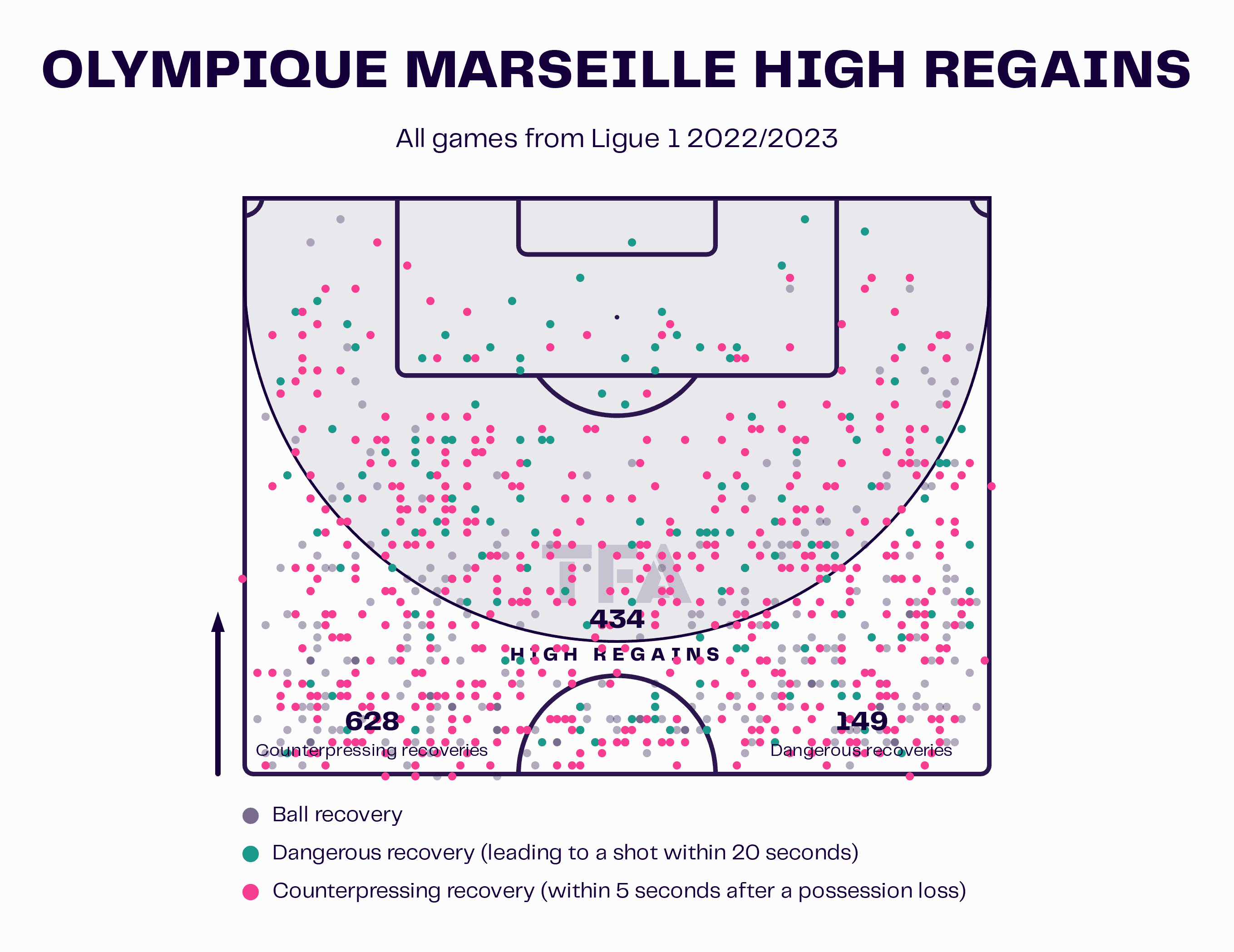
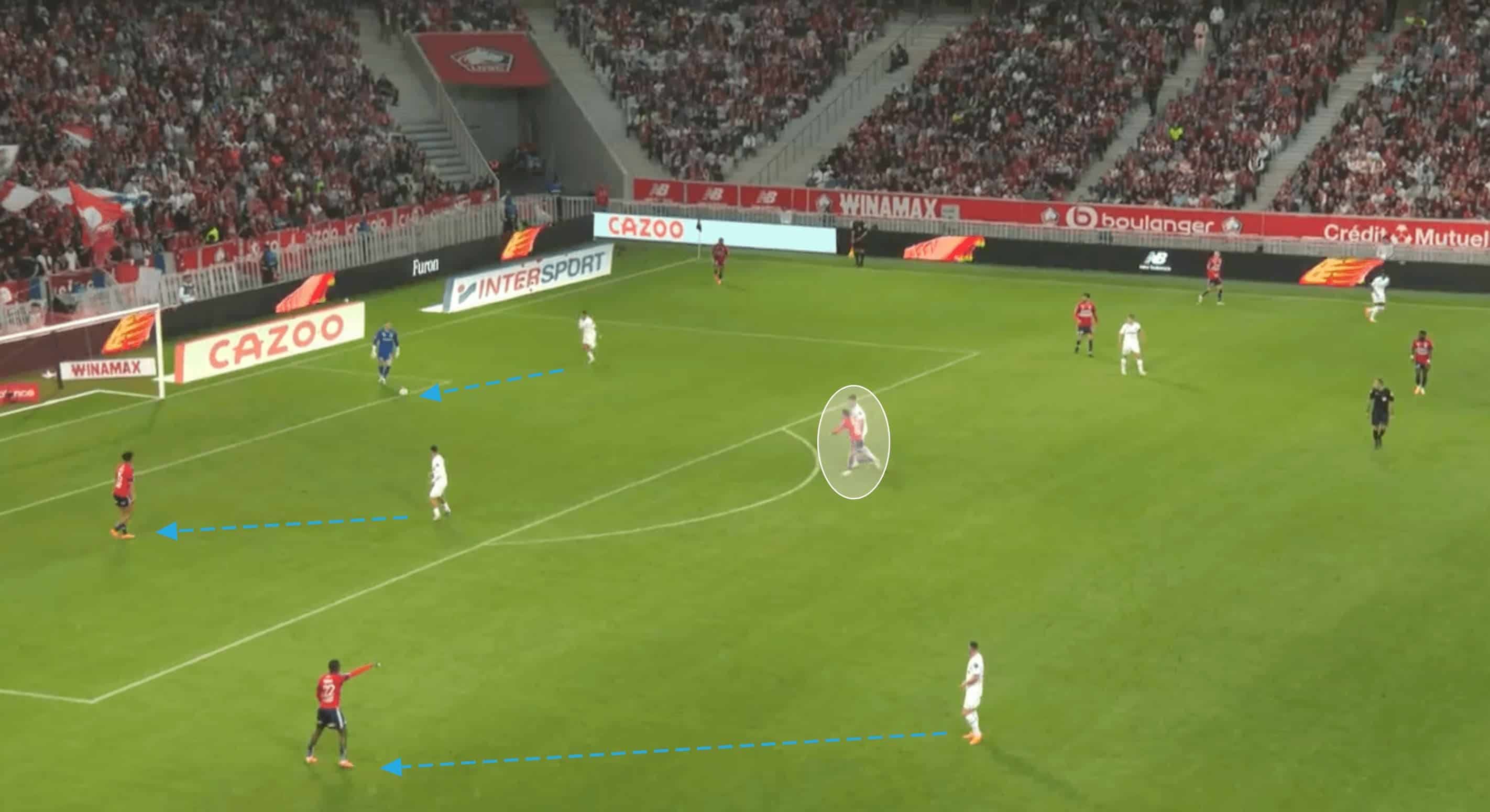
An example of Tudor’s high pressing can be seen above as Marseille look to prevent Lille from playing out of defence. Furthermore, the images below show how Tudor’s high press led directly to a goal. Marseille initiated a press to prevent Nice from playing out and regained possession. This led to a counterattack, and Alexis Sánchez was able to put them 1-0 up.
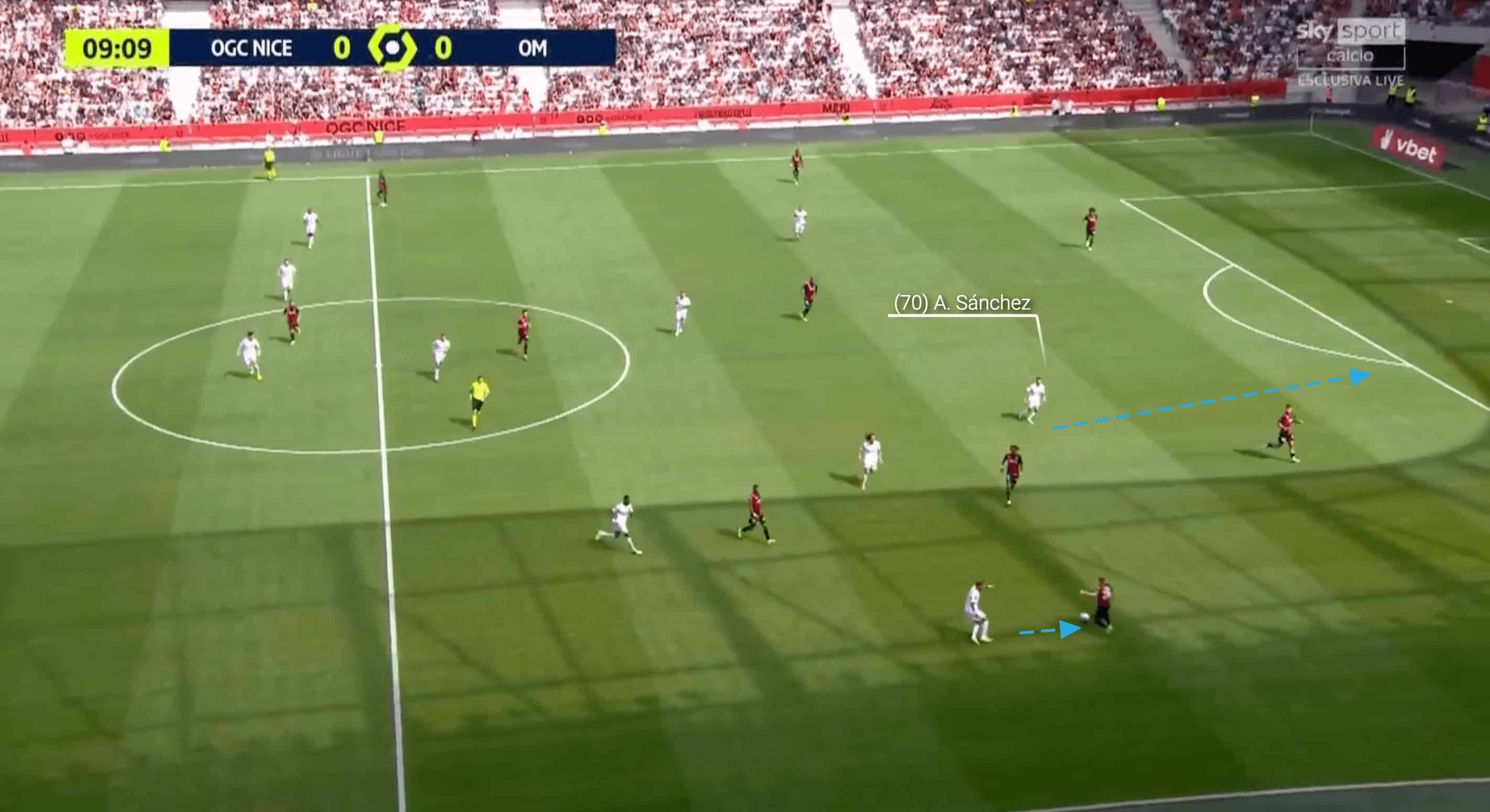
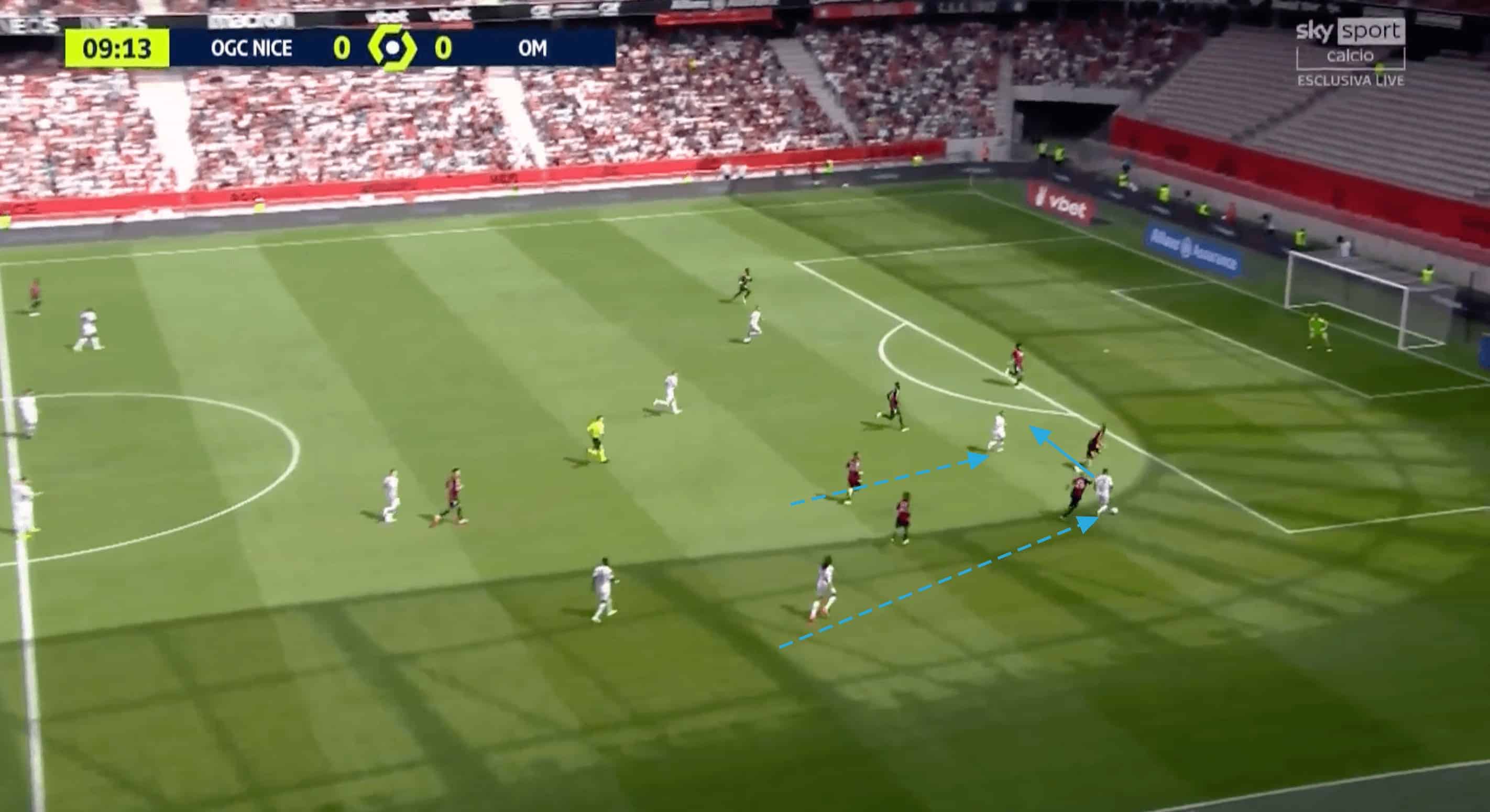
As Tudor guided OM to a third-place finish, the team averaged 1.76 goals per 90 from an xG of 1.93 per 90. This led to 67 goals being scored throughout the Ligue 1 season. At the opposite end of the pitch, Marseille conceded 1.05 goals per 90 which meant they let in 40 goals over the season, two more than the previous season.
Looking ahead: 2023/24
Igor Tudor departed OM at the end of the 2022/23 season, and Longoria turned to his trusted former colleague Marcelino. The transfer window has been relatively quiet by Marseille’s standards. However, Pablo Longoria appears to have been incredibly shrewd and made some well-thought-out signings.
Former Sheffield United talisman Iliman Ndiaye opted to return to his boyhood club, with the Blades receiving €12m for their star man. Signing the Senegal international was a clever piece of business by the OM President as he entered the final year of his contract at Bramall Lane.
We can see from the pizza chart below how Ndiaye compared to fellow strikers in the EFL Championship last season. The 23-year-old brings some dynamic attacking skills to the team; not only can he play as a forward, he will often drop into pockets of space, as a number 10 would to pick up the ball, which means he will likely be a pivotal element to OM’s build-up play.
Ndiaye scored 14 goals from an xG of 14.02 and contributed nine assists from an xA of 3.31, so it’s fair to say that he can create plenty of opportunities for teammates. We can see from the pizza chart that he loves to carry the ball forward, which means he could be the player that the team looks to when transitioning from defence to attack, as he has plenty of dribbling abilities to move the team up the pitch swiftly.
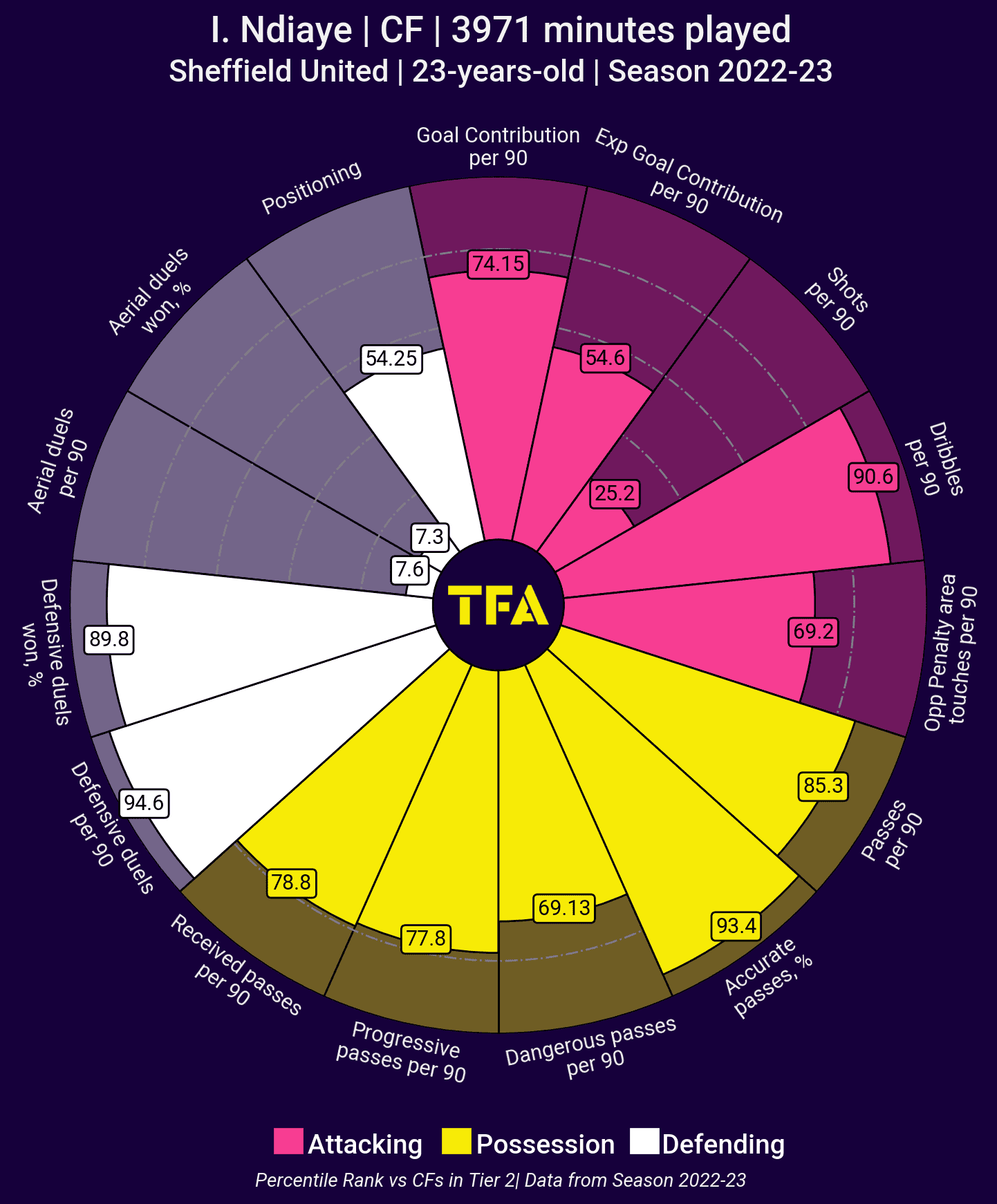
Left-back Renan Lodi made the move to the South of France for a fee of €13m as the replacement for Sead Kolašinac, who departed on a free transfer. Whilst Lodi didn’t enjoy the best of seasons out on loan at Nottingham Forest, he is only 25 years old, so if he can settle and perform well for Marseille, the club may have their left-back position locked down for several years to come.
Longoria also brought in two vastly experienced players in the shape of Geoffrey Kondogbia (€8m from Atletico Madrid) and Pierre-Emerick Emiliano François Aubameyang (free transfer).
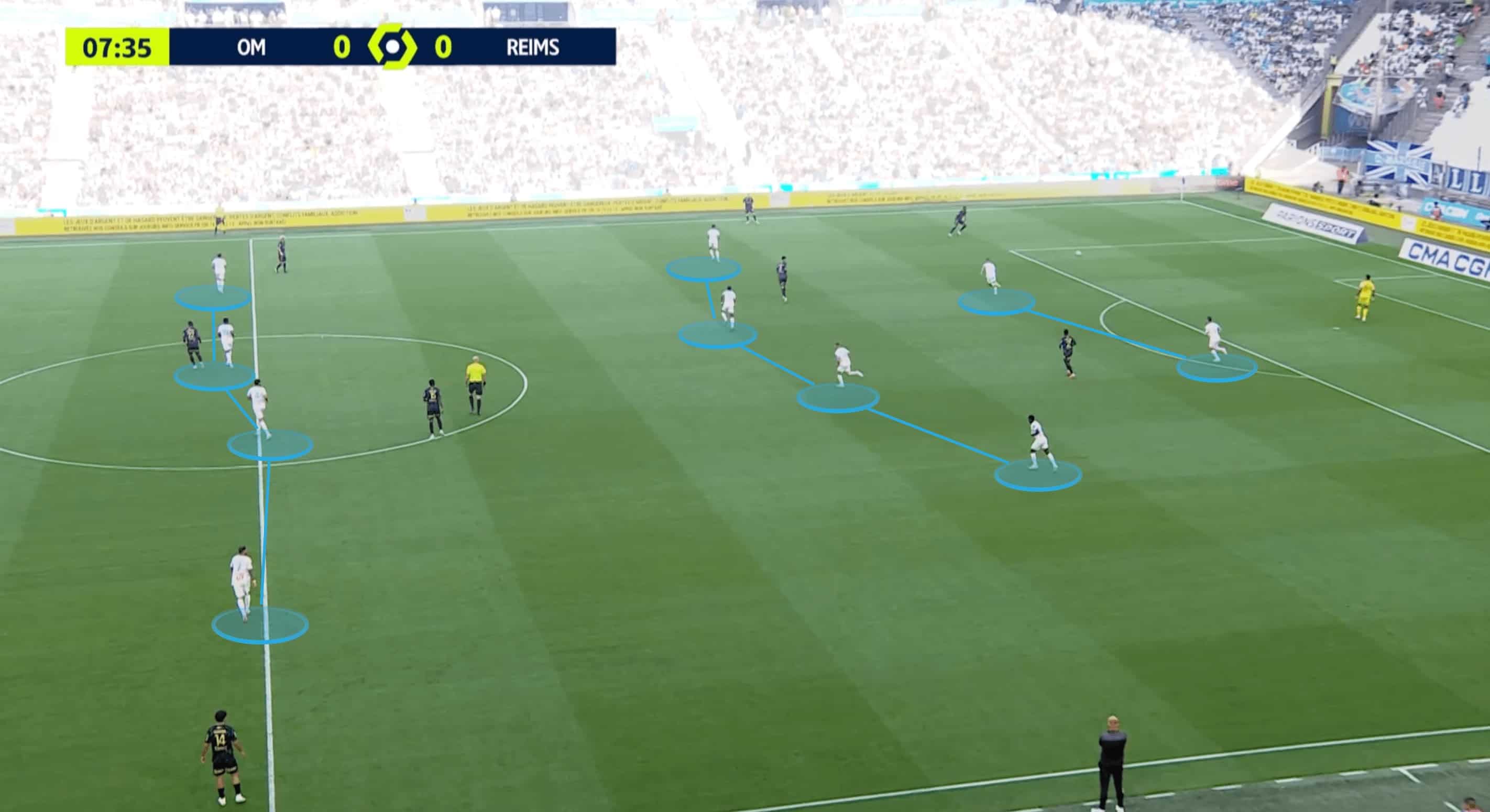
As many people expected, Marcelino has brought his famous 4-4-2 system to the Stade Vélodrome. He is the ideal replacement for Tudor in many respects in many respects as his style continues in the same vein of high pressing, as we can see above. Out of possession, Marcelino likes his team to press high and look to force errors — Athletic Club had a PPDA of 9.84 during the 2021/22 season that he was in charge.
When in possession and building up from defence, Marcelino’s teams generally form a 4-2-2-2 shape. So, in OM’s case, the two central midfielders will drop a little deeper, whilst Iliman Ndiaye will drop deeper, and one of the wide players will tuck in to form the next block of two whilst Aubameyang and the other winger will form a front two.
Furthermore, the full-backs, Clauss and Lodi, are often given licence to get forward, with one often higher than the other, and the goalkeeper will act as an extra outfield play, so in some cases, Marseille’s build-up play will look for like a 3-3-3-2.
This can be a way of ensuring they retain possession and build up playing through the lines as it allows them to stretch the pitch as shown below, there are pockets of space open which could be exploited.
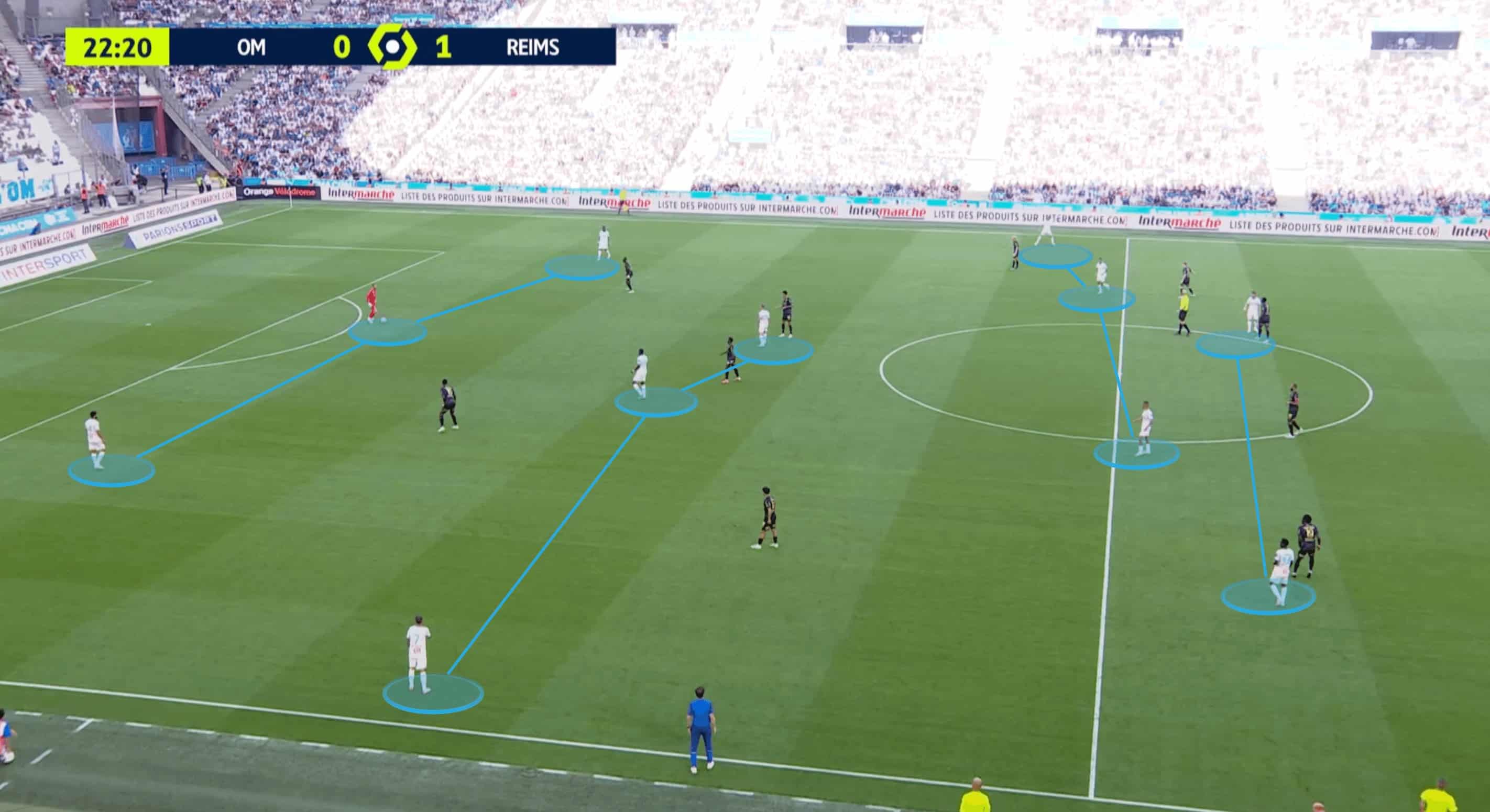
Conclusion
Overall, despite the vast turnover of players and managers since Pablo Longoria has been at Marseille, his business decisions have positively affected the club. OM have made excellent use of the loan market, which helped them secure Champions League football.
Looking at the 2023/24 season, Longoria has put together a squad with a great mix of youth and experience. It appears that his previous decisions have allowed Marseille to reach a point where they could mount a viable challenge for the Ligue 1 title.
Although Longoria hasn’t always been a popular figure amongst Marseille fans, and plenty of managers have questioned his decisions, if OM are able to secure a title, he will have certainly played a considerable part.

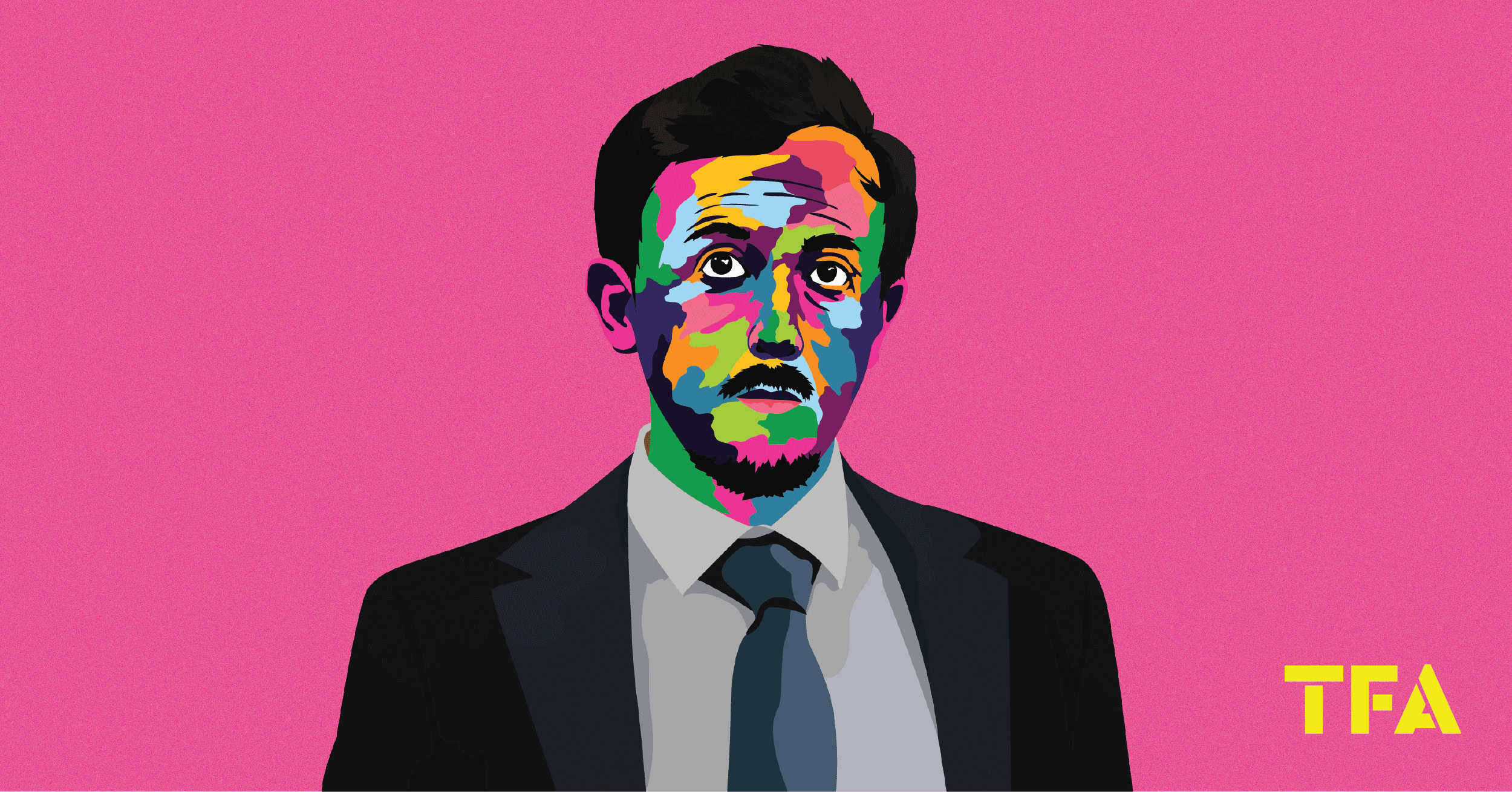


Comments